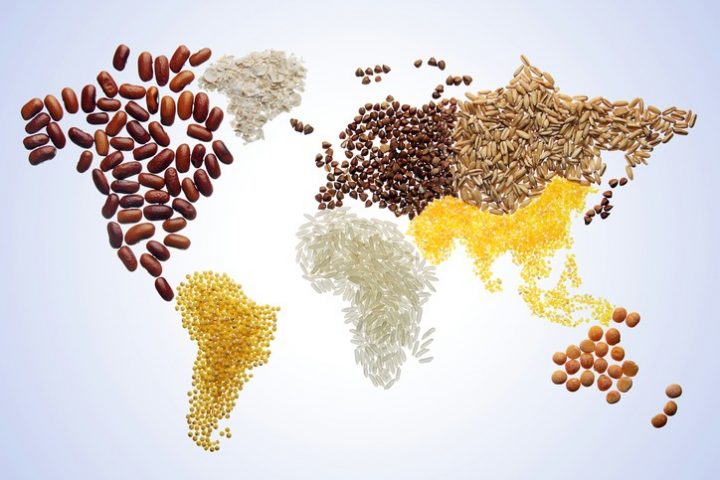What do major agricultural forecasters say about the 2021/22 global grains and oilseeds season

World map with various grains
BY | MAY 11, 2021 | AGRICULTURAL PRODUCTION | 0 COMMENTS
The outlook for global agricultural conditions is once again in the spotlight this week as the United States Department of Agriculture (USDA) is scheduled to release its projections for the 2021/22 production season on May 12.
Another major global agricultural organisation, the International Grains Council (IGC), released its estimates last week and painted a generally optimistic view for key grains and oilseeds production for 2021/22.
Starting with maize, the IGC forecasts global production at 1,2 billion tonnes, which is up by 5% from the 2020/21 production season. This optimism is underpinned by expectations of a large crop in the US, Brazil, Argentina, Ukraine, China, EU and Russia. The reaction to the release of this data was generally muted.
Some market participants are currently more focused on the near-term issues affecting the crop, such as persistent dryness in Brazil, which negatively affects the country’s 2020/21 second maize crop, also known as “safrinha”. The 2021/22 maize crop will only be planted towards the end of the year across the Southern Hemisphere and is therefore not an immediate focus.
Another concern in the market is dryness in parts of the US and Canada, threatening and slowing the 2021/22 maize crop. Moreover, parts of the EU have also experienced delays in planting because of the cold spell. Nevertheless, the IGC maintains a reasonably positive view of maize production estimates of all the aforementioned countries, as they are evidently amongst those underpinning the expected 1,2 billion tonnes of maize in 2021/22, as we previously stated.
The one question that will remain on analysts’ minds after the release of the USDA’s data on Wednesday is whether the global maize stocks would recover after an anticipated improvement in production. How the market interprets this data in this respect could have an effect on global maize prices. These are currently at the highest levels since 2013, because of the dryness in parts of South America, combined with rising maize demand from China. So far, the IGC estimates global maize stocks at the end of 2021/22 to be the smallest in nine years, at 264 million tonnes (down 3% y/y), in part, due to rising global consumption.
Moving to wheat, the IGC forecasts a 2% y/y increase in 2021/22 production to a record 790 million tonnes. This is primarily attributed to better outlooks in Europe and North Africa, the US, Ukraine, China, UK, and India, amongst other countries. There are expectations of better yields compared to the 2020/21 season and an increase in area plantings. Unlike maize, the 2021/22 global wheat stocks could recover by 3% y/y, partly because of expected large global wheat production. While we are yet to see what the USDA will present, rising production and stocks would ideally lead to a softening in prices. This would be beneficial for importing countries such as South Africa.
The IGC forecasts a 6% increase in 2021/22 global soybeans production to a record 383 million tonnes. The current higher global prices are expected to incentivize farmers to lift plantings, and there are also expectations of better yields which would also boost the output. The major contributing countries to this IGC forecast are the US, Brazil, Argentina, India, Paraguay, Russia and Ukraine. For the Southern Hemisphere countries, we will only know if the optimism in plantings holds at the end of this year. At this stage, the focus is on the 2020/21 production season, which for Brazil is not looking well because of dryness, as we have already stated. Importantly, if everything were to go as the IGC estimates, the 2021/22 global soybeans stocks would recover by 8% y/y to 50 million tonnes. Such a recovery would have slight downward pressure on prices which have remained fairly elevated primarily because of strong Chinese demand.
Lastly, we consistently keep an eye on another important grain, mainly as South Africa imports all of its million tonnes annual consumption, i.e., rice. Here the 2021/22 production outlook is positive; the IGC forecasts a global crop of 509 million tonnes, which is up by 1% y/y. India, Vietnam, Thailand, Pakistan, Indonesia, Bangladesh and the Philippines are all amongst the key countries set to contribute positively to a large global rice harvest for the 2021/22 production season. The planting activity in many of these countries will only begin in June. Still, the weather conditions and soil moisture are reportedly good, which should support cultivation when the season commences.
An exogenous negative factor for key producing countries is the ongoing spread of Covid-19 infections as currently being witnessed in India. We continue to monitor if these could negatively impact farmers activities in the fields. Notably, the IGC forecasts a 25 y/y increase in 2021/22 global rise stocks to 176 million tonnes. Similar to wheat, a recovery in stocks would potentially add downward pressure on prices in the coming months, which is beneficial for importers like South Africa.
Ultimately, the initial production forecasts for the 2021/22 global grains and oilseeds production paint a slightly better picture than many had feared. If more on-the-ground evidence emerges to support these forecasts, then in the coming months, the global agricultural prices would potentially cool off from the current higher levels as illustrated by the FAO Global Grains Price Index.
We look forward to observing if the USDA’s estimates will concur with the IGC’s view or if there is material deviation. If they agree, then this would bring about some additional optimism in the market and the current spell of elevated commodity prices could be somewhat short-lived.
Follow me on Twitter (@WandileSihlobo). E-mail: wandile@agbiz.co.za



